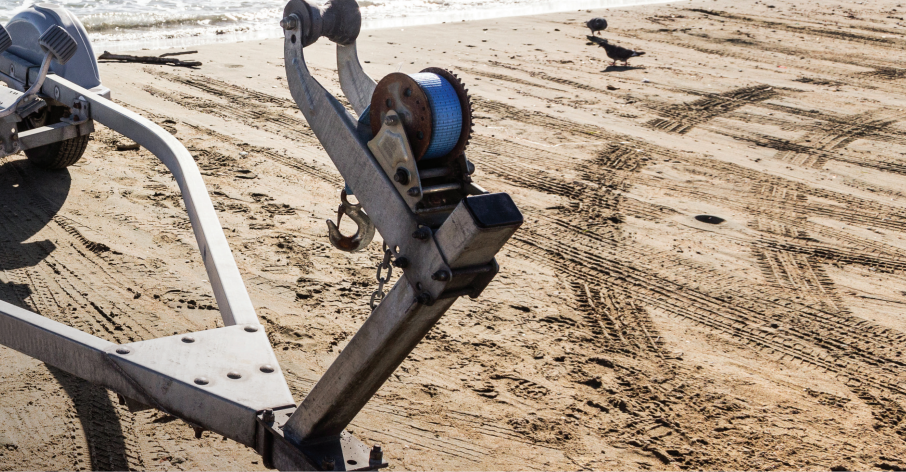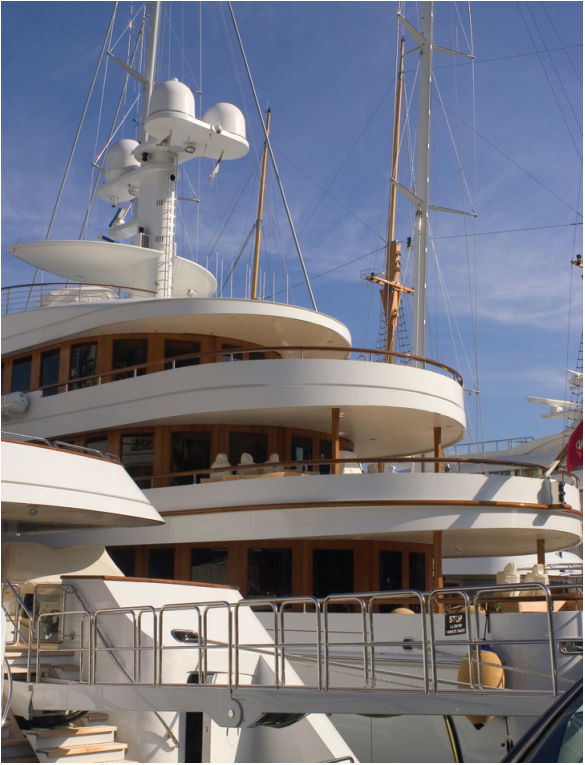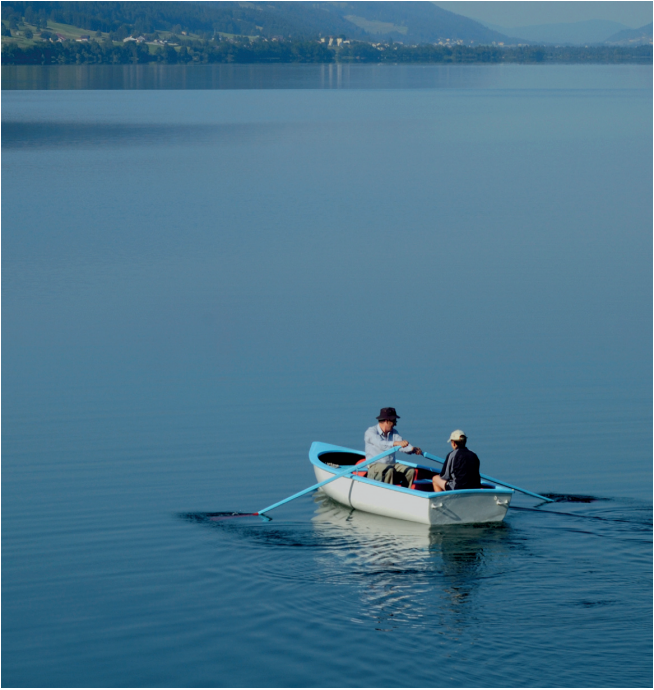Buying a Trailer

You have your nice boat – but are faced with the problem of where to put it. If you have a large boat, then you have no choice but to use a marina or mooring. However, for boats up to, say, 25 or 26 feet, then storing your boat on a trailer is a very viable option. Most small boats, RIBs and dinghies can easily and safely be stored and transported on a properly constructed trailer. So – what are the advantages and disadvantages of a trailer? The good news Let’s look at cost first. A good, new, trailer for a 16 footer boat costs about £2,500. The marina berthing fees are typically about this – except you have to pay them every year. The savings on marina fees is like getting 100% interest on your investment! That’s a great financial incentive. If you want to do any work on your boat, storing it at home on the trailer is much more convenient than having to traipse down to the marina. I know from bitter experience that having gone down to the marina, you often don’t have the right tool with you to finish the job A trailer means that you don’t have to keep the boat in the water, and can give it a freshwater wash-down after every trip. This keeps the hull in great condition. It also means that you don’t have to antifoul the hull – giving you another annual financial saving. Having the boat at home means that you can go to whichever part of the country you wish – you are not tied to your usual marina. All you need is a suitable launching ramp or slipway. There are many across the country, and the public ones are free of charge. Websites such as Boatlaunch list suitable sites in the UK and near Europe. Clicking on the map in the locality you want brings up detailed information on each slipway and its suitability for different types of boat. Disadvantages Of course, you need four essentials – a boat small enough to be trailed, the trailer itself, a car capable of towing the trailer and boat and finally somewhere (on your driveway or elsewhere) to store them. If you don’t have these then unfortunately a trailer option is not viable. Size matters Choosing the right size of trailer for your boat is important. Trailers are typically suitable for everything from a small sailing dinghy right up to a 25 or 26 footer. They are not usually viable for sailing yachts with a deep keel. You can of course get a trailer for small deep keel boats, but you then usually have to launch them via a crane, rather than a ramp – and the cost of cranage negates any cost savings. The size and weight of the boat determines the size of trailer you need. You need to take account of the LOA (length overall), plus any outboards. Weight matters The relevant weight is the weight of the boat dry, plus the weight of fuel, freshwater and blackwater on board, plus all the ‘essential’ bits and bobs that seem to get crammed into boats. Heavier boats may require a twin-axle trailer. The trailer does not have to have brakes if the weight of the gross trailer weight is less than 750kg or half the towing vehicle’s kerb weight – whichever is less. The full set of rules are complex. Go Earth can assist in any sizing questions you may have. Just contact us, and we will try to help. Adjustability A key element when finding a suitable trailer is adjustability. It has to fit your boat – and continue to fit your boat as you load and unload it. There are several elements to this. Firstly as you load the boat, the rollers should automatically adjust to the changing profile of your boat’s hull. Indespension trailers do this by their swing axle method so that the change in the bow-stern dimensions are covered. (see photo) Then the change in the portstarboard dimension (i.e. the keel angle) is covered by the pivoting of the rollers arms (see photo). Indespension trailers pioneered this swing axle design (see the video below for a demonstration) which is a key feature of their boat trailers. In addition, for larger adjustability, all the main components should be attached to the framework by U-bolts. Then you can very easily adjust all the dimensions by unscrewing the nuts, moving the U-bolts, and then re-tightening. Indespension, again, have majored on the concept of completely bolted trailers. (The bolts are actually rectangular to fit the shape of the components, rather than ‘U’ shaped, but everyone calls them U-bolts!) This provides both adjustability and ease of replacing any damaged components. Some boat manufacturers will try to sell you a trailer when you are buying a new boat. That’s fine as far as it goes – but there is a catch. The trailer is often built just for that model of boat, and often has no or limited adjustability. What happens if, when you eventually sell the boat, the new purchaser does not want a trailer if, for example, they have a berth somewhere? You would be left with an almost useless trailer. Our general recommendation is to purchase a trailer with a wide range of adjustability such as the Indespension range. https://www.youtube.com/watch?v=GRlp5UeQaFs Size and weight matters – again You have your boat. You have the right trailer. Now you need a suitable car or other towing vehicle. Most cars can take a tow bar at the rear. Notable exceptions include Porsche 911s, and a few other specialist cars. The towing weight of a car is defined by the manufacturer. It is sometimes called the ‘gross train weight’, and may be in the owner’s handbook or on the VIN plate on the car. You need to check the combined weight of the boat, trailer, and all the various bits of boating paraphernalia that you will throw into
Buying a Boat – Getting the Right Advice

See a boat you like? Fall in love with it at first sight? Immediately reach for your wallet? That’s all fine – however, you want to be sure that it is a boat that you will continue to be in love with even after that first flush of romance. You need to ensure that the boat continues to provide fun, pleasure and thrills for many years to come. That’s why you should take independent professional advice to help you get the best boat and have the best value for your money. Let’s consider the need for, and some sources of, advice. Why is advice needed? You may very well be experienced in your profession or business. Possibly used to negotiating or being part of a project. Maybe you have technical skills. These are useful. However, we believe that buying a boat is simply more complicated. Think of a boat as a combination of a house, a car, and one that (hopefully!) floats on the water. Multiply those complexities together. This is not a problem in itself, provided that you get the right advice to help you make the right decisions. Sources of advice There are of course multiple sources of advice you can use. The internet provides a great variety of advice. Often, however, you need to know what questions to ask, where to look, who to believe. The internet can be useful; but it can also provide conflicting and unreliable advice. Frankly, I have seen some advice on the internet that makes me cringe as the advice has simply been wrong or even dangerous! Surveyors are an essential and important part of boat buying. However, you need to know how to choose a good surveyor, understand the different types of surveyors and surveys, and how to make best use of surveyors to actually save you money. If you are looking at a boat that has had a previous survey done – maybe a year or two ago – we advise you NOT to rely on it for several reasons. Firstly, the survey is the property of the vendor, not you, so the surveyor owes zero responsibility to you. Next, some issues could have arisen since the survey. Also, if you have been given the survey, then you have been informed of any issues identified, and so you have no come back or room for negotiation on those issues. In a nutshell – you need to get your own survey done. Go Earth can recommend the types of survey(s) you need and assist in finding a suitable surveyor. Brokers are of course often ready to be helpful and give advice. However, please remember that their legal, contractual relationship is with the seller, not you as the (potential) buyer. Also, they – naturally enough – want to sell you a boat on their books. That’s what their job is. Further, if you ask the broker for information, they may simply be unable to give you accurate or full information because they may not know all the boats on their books. Also, it has been known for the seller to forget to tell the broker about significant issues with a boat! Solicitors may be needed for large or complex transactions. However, most solicitors are not specialists in marine matters. Your personal solicitor may, therefore, not be the most appropriate one for a boat purchase. We can help you find a specialist marine solicitor. Go Earth is not associated with any boat broker or boat manufacturer. We are independent. Our mission is to help boaters through all the stages of buying a boat. To do this we provide a variety of services. We can act as your professional advisor and procurement agent. The professional advisory element is typically focussed around requirement specification and identifying makes / models of boats that fit your requirements. Note that we are starting from ‘what are your requirements?’; not from ‘that’s a nice-looking boat, let’s buy it’! Of course, it is not always easy to define your requirements; and so we can help with that process. The procurement agent does what any procurement agent in any industry does – tries to get you the best product at the lowest possible price. Go Earth is an example of a procurement agent, and provides a range of services to help you get the right boat at the best (i.e. lowest) price. While of course nobody is going to give a boat away, a procurement agent can negotiate on your behalf to ensure that you buy at the very lowest viable price. In summary, our services include boat search, boat pre-visits, and perhaps most importantly boat negotiation services. We always recognise that it is your money, and so we will do as little or as much as you want. Our Boats for Sale Listing Explore our select collection of boats! Click Here
Buying a Superyacht

For many people, buying a superyacht is the culmination of a dream. For others, it must remain just that – a dream. This article is intended to help you – either in reality or in your dreams! Definition It is difficult to define what is meant by ‘superyacht’. You can define it in many ways – by size, by the possible need for crew, by cost, by design. Although this article focusses on superyachts, many of the points are equally relevant to lower value transactions. Why buying a superyacht is different There are many more factors to consider when buying a superyacht compared to a smaller boat. These factors can be practical, logistical, financial, location, size, design (interior and technical), self-drive and/or crewed, foreign exchange, regulations in other countries. None of these are problems in themselves – provided that you do it properly, with proper consideration and professional advice. A project The key thing is to realise that buying a superyacht must be treated as a project, not a simple transaction. The complexities of purchase exceed those of even a high-end car or property. If it helps, think of your superyacht as a property combined with a high-powered car that floats and can move between multiple locations and jurisdictions; and then multiply those complexities together. Put simply, do it right and you will end up with a superb, enjoyable, luxurious, asset. Alternatively, buy it on a whim, and spend time and money regretting it. So – how do you manage the purchase process successfully to maximise the pleasure and minimise the cost and your time? At Go Earth, we break the process down into multiple stages, which at a very high level are: • Initial requirements specification• Boat search (refining the requirements if necessary)• Boat negotiation• Validation (survey, legalities, finance)• Completion Initial requirements specification To state the obvious, think about what you want. Initially, perhaps you only have a general idea. This may be an iterative process, where you define and refine your exact requirements as you go along. Some things to think about include: What uses will you make of the boat? Will you want to stay on board? If so, just for weekends or for longer? How far will you want to travel? Will you want to work on board? How many friends and family will you want to accommodate? Do you want a luxury machine or a speed machine or perhaps both? What engines – or sails – do you need? How about the galley? What electronic systems are needed? Does the keel type matter? What about contractual matters when purchasing? What types of surveys do you need? What is viable within your budget? Are you going to charter it out? Will it need coding? It’s your money, and you want to spend it on what suits you. A professional buyer’s agent (yes, such as Go Earth!) can assist in all this. Boat search – refining the requirements if necessary This can also be an iterative process. You search (possibly, we hope, with the help of Go Earth), find a number of superyachts that seem to fit the bill. The process may highlight features that you had not thought about. Adjust your requirements accordingly. Hopefully you then end up with a ‘long list’ which can be whittled down to a ‘short list’ of serious contenders. A key initial question is ‘new or used?’. Whilst a new yacht may seem attractive, you need to be aware of the pitfalls. Firstly, if it is a new build, (as opposed to a boat in stock), then you will be spending a lot of money for a significant period of time before you can even begin to enjoy your purchase. There is also the risk of the yard going into liquidation mid-build. It does happen – and, while rare, happens more frequently than is desirable. Of course, the contract might provide you with a degree of protection – but even if you get ownership of the half-built hull, that is of limited consolation. The big advantage of a new build is of course that it is built to your taste and specification. The degree of customisation can vary. Most yards offer a certain degree of customisation, while others will take on a semi-custom or completely bespoke project. Ironically, the advantage of a used boat is that you know exactly what you are getting – or at least you do after a comprehensive survey and sea trial. Also, just like cars, a used vessel can be significantly better value than a new one. Let someone else take the depreciation hit. Of course, if you then want to make changes to the décor, you can do so – just ensure that you have budgeted for this. Industry knowledge is essential when looking for your first, or next, superyacht. Although many superyachts are advertised widely, some are not for personal or business reasons. In the superyacht world, confidentiality is essential. Certainly, Go Earth, through its bespoke boat search service, can assist you in this search process. If you are ‘time-poor’, a good buyer’s agent can pre-visit a selection of boats for you, take numerous photographs, and even provide a virtual reality walk through of the superyacht for you. Whilst such activities are not cheap, you may be making better use of your time running your business; and only personally visiting a short list of those vessels that appear to suit you and that you like the look of. Boat negotiation Price negotiation is an essential part of the process. Brokers do prefer to be able to tie you down to a price as soon as they can. This is not surprising. It’s their job, after all. Negotiation can become very emotional, especially considering the sums involved. Buyer’s agents such as Go Earth can provide a buffer and enable negotiations to be conducted so that that you end up with the best viable deal. Brokers like to ‘qualify’ potential buyers. Is he/she a serious
Moving On Up (With Apologies to M People!)

Moving from this… …to this There comes a time in the life of every boater when they decide it is time for a change. You have had your boat – and it’s been great while it lasted. However, now you may want a faster, younger or bigger (or possibly smaller) model. Or perhaps simply move from sail to power, or power to sail. Why move? Your motives may be many. Possibly you are no longer as active as you once were and now is the time to move from sail to power. Maybe you bought your first boat with limited knowledge and now have a better view of what exactly suits you. It could be that your first boat was simply a trial – to see if you liked boating – and you have now decided that you do and want something better (= more expensive!). Possibly the ‘joys of berthing’ have convinced you that you now need a boat with greater and easier manoeuvrability in crowded marinas using features such as a bow thruster, twin engines, joystick control and automatic fenders. Perhaps you want to cash in part of your pension, have just sold your business, have won the lottery or received a great inheritance. Whatever your source of finance, you want to enjoy the benefits of it. Making the move – sell and buy, or buy and sell? The first question is – do you have to sell your current boat first – or can you buy your next boat without having sold your first one? This is primarily a question of finance. If you have the funds, there is no need to wait until your current boat is sold. However, don’t forget that you then have expenses on two boats, not one, until your current boat is sold. Of course, you could try and do a part-exchange. This might work for you – however part-exchanging is far more problematic than part-exchanging a car. If it’s a private sale and purchase, you are very unlikely to find someone who has a boat that you want and who also wants the boat you currently have. If it’s via a broker, then usually the broker would have to take your boat into stock. Most brokers are reluctant to do this, as their business model is a broking one, unlike most motor traders. They rarely take into stock and sell on their own behalf. For those brokers that are willing to take boats into stock, they are often only willing to do so if the boat you are buying is of much higher value than the one you are selling. Also, you won’t be surprised to hear, they often don’t give great prices for boats they buy. Therefore, you usually get best value by separating out the selling part and the buying part of getting your next boat. Making the move – what do you want, really really want? (with apologies to The Spice Girls!) Next, consider exactly why you are making the move. If it is for space on board – then this is the most common reason why people move. However, there is an unfortunate rule of thumb about this – the price of a boat is (very roughly) proportional to the cube of its length, everything else being equal. So – to move from, say a 25 footer to a 50 footer, this doesn’t just double the cost – it multiplies it by a factor of (maybe) about 8 times. This ‘cubing rule’ is logical if you think about it – you are increasing not just the length, but also the beam and the height. Bottom line – if you want to move to something significantly bigger, you have to be prepared to spend the money. However, at Go Earth our speciality is boat procurement, so we can help you save at least a proportion of that extra cash. That’s what we do. Some factors to take into account include: Budget – capital expenditure and ongoing expenses Will you be travelling further afield – in which case, this impacts: Boat size and ocean-going capability Storage requirements on board Specialist kit, such as water-makers Boat category Insurance Communications – such as satellite radios The wishes, experience and capabilities of your crew Internet access- such as the need for your daily fix of Facebook? For a superyacht, you may not be able to get into some local marinas and harbours. So you would anchor off and use a tender to get ashore. You would therefore need to budget for a decent tender – one that will get you comfortably ashore even if the weather is a bit ‘dodgy’. You may be using a crew for the first time. Getting good advice WHERE TO GET ADVICE Having had a boat already, you already know a bit about boating. However, if you are moving up, you may be moving into a different league, with different issues, different technologies, a different mix of good and not-so-good brands with different makes and models. In particular, you may be spending more than you did on your current boat. Indeed, it is not uncommon for our clients to spend substantially more on their next boat than their current one. You need to get it right. At Go Earth, we argue that you still need unbiased advice from a trusted representative that is acting on your behalf – on the buyers behalf, not the sellers. This is a service that we provide. When we first started the company, we expected the majority of our clients to be people buying their first boat. In fact, we have had roughly a 60/40 split in favour of people buying their second or third or even fourth boat. We have often heard the comment “we wish that we had known about you when we bought our first boat!”. Our initial consultations are free – that is, free of cost, free of hassle, free of any commitment. We have
